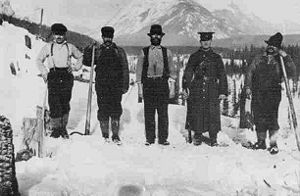Ukrainian Canadian Internment
The Ukrainian Canadian internment was the confinement of over 5,000 Ukrainian adult men immigrants from 1914 to 1920. They were enemy aliens because they were citizens of the Austro-Hungarian Empire, with which Canada was at war. At the time many were called by the provincial origins in Europe as "Galician" and "Bukovynian", or as "Ruthenian." They were kept in 26 internment camps across Canada. 80,000 other Ukrainian immigrants, mostly women and children, were required to report to the police. The internees were kept separate from Ukrainian prisoners of war captured in France. The internees mostly did construction work in rural areas; they were paid the same wage as Canadian soldiers, and given free food, shelter, clothing and medical care, but were not allowed to leave. There was a riot in 1916 in the Kapuskasing internment camp, involving some 1,200 prisoners. Most were released when the war ended; some were kept until February 1920..
The internment of the civilians was the result of wartime fears of enemy sabotage, although the Ukrainians had little or no loyalty to the Austro-Hungarian Empire. Ukrainians were vulnerable because of the dominance of the restrictive, 'imperialist' understanding of how non-British immigrants ought to be integrated into the polity. Meanwhile, the outbreak of war worsened public attitudes against enemy aliens and increased levels of poverty and unemployment among immigrant Ukrainians. These developments led the national government to pass the War Measures Act of 1914, forcing immigrants into conscription into the army or assignment to work camps.
Terminology
The camps that the immigrants were placed in were called concentration camps at the time. The camps had adequate food and housing and there was no brutality.[1]
In 1914, Canada passed the War Measures Act, which required "aliens of enemy nationality" to register with the police.[2] Because of their emigration form territories under the control of the Austro-Hungarian Empire, this effected around 80,000 Ukrainians.
The Internment
From 1914-1920, 8,579 men were interned by the Canadian government and placed in concentration camps. Of these, over 5,000 were Ukrainians. The others were mostly Poles, Hungarians, Croats, Serbs, and Slovaks. Most of these were men, though some woman and children were also interned. Victims had all of their property and wealth confiscated by the Canadian government, and never returned. Those interned were placed in one of twenty four concentration camps across Canada. There they were forced to do heavy labor to profit the government under abusive conditions.[3] They were used to develop Banff National Park, the logging industry in Northern Ontario & Quebec, and the steel mills in Ontario & Nova Scotia, and in the mines in British Columbia, Ontario & Nova Scotia. This was so beneficial to Canadian corporations that the internment was carried on for two years after the end of World War I.[4] Over 100 Ukrainians died through injuries and diseases sustained in the camps, or trying to escape.
Legacy
The Royal Canadian Mounted Police closely watched Ukrainians and concluded the community as a whole was loyal to Canada.[5]
The internment is generally regarded by Canadians as a shameful part of their history. Racism and xenophobia persisted and the same act was used as the basis of the internment of the Japanese Canadians in 1941. In 2005, the Canadian government, through Bill C-331, acknowledged that the Ukrainians were unjustly interned in concentration camps and agreed to "an agreement concerning measures that may be taken to recognize the internment".[6] Nothing has been done so far. The last living survivor of this tragedy, Mary Manko Haskett, passed away on July 14, meaning that no victim was ever able to witness a reconciliation.[7]
Readings
- Farney, James and Kordan, Bohdan S. "The Predicament of Belonging: the Status of Enemy Aliens in Canada, 1914." Journal of Canadian Studies 2005 39(1): 74-89
- J.B. Gregorovich, ed. Ukrainian Canadians in Canada's Wars: Materials for Ukrainian Canadian History, (Toronto, 1983),
- Luciuk, Lubomyr. In Fear of the Barbed Wire Fence: Canada's First National Internment Operations and the Ukrainian Canadians, 1914-1920. (2001), 170pp
- F. Swyripa and J.H. Thompson, eds. Loyalties in Conflict: Ukrainians in Canada During the Great War (Edmonton, 1983)
References
- ↑ The term "concentration camp" was used at the time. See for example, the Officer Commanding, 5th Military Division, Quebec, to Major General Otter, 4 January 1915 in National Archives of Canada (NAC) Record Group (RG) 24, Volume 4513, File 2
- ↑ Text of Act
- ↑ Peter Melnycky Badly Treated in Every Way
- ↑ Lubomyr Luciuk A Time For Atonement
- ↑ Myron Momryk, "The Royal Canadian Mounted Police and the Surveillance of the Ukrainian Community in Canada.," Journal of Ukrainian Studies 2003 28(2): 89-112
- ↑ Bill C-331
- ↑ http://ucclanews.livejournal.com/4306.html

